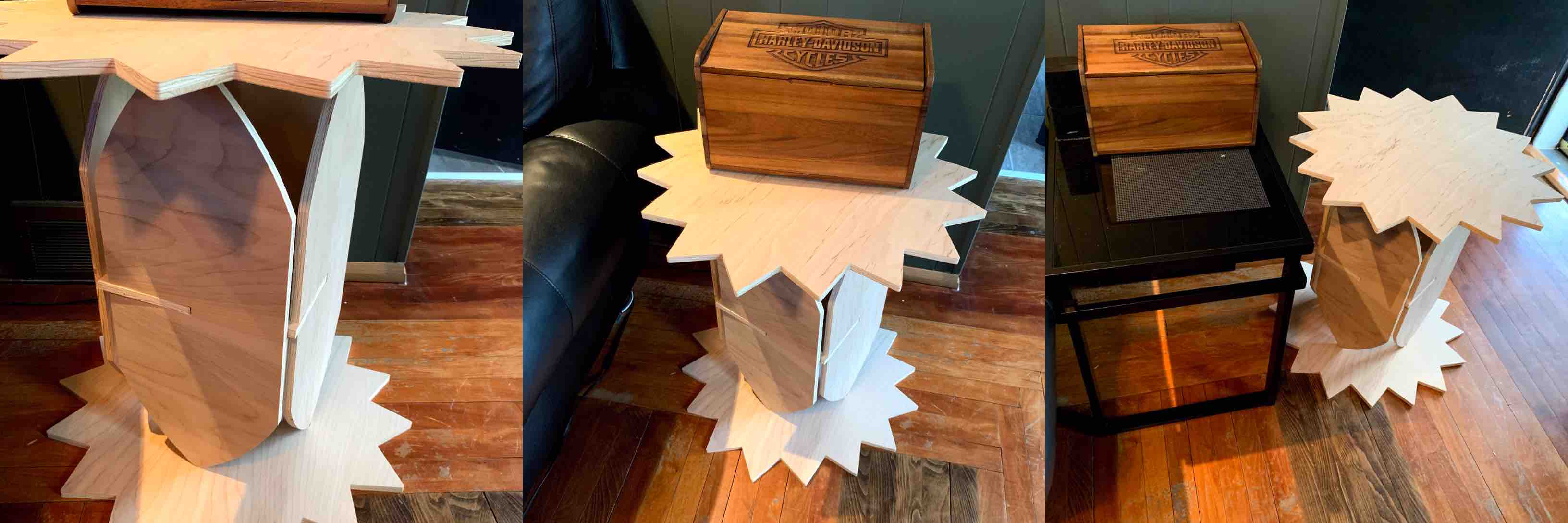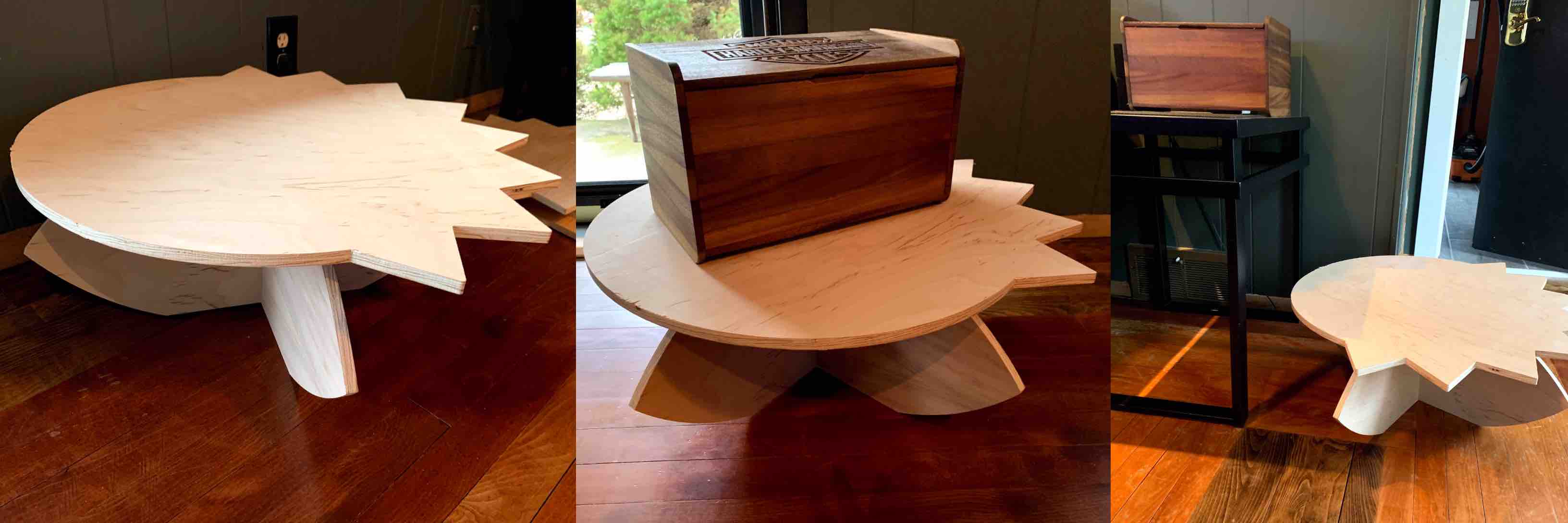10. Applications and Implications¶
This week I worked on further defining my final project idea and documenting my plans and procedures to create the final project.
Research¶
Propose a final project masterpiece that integrates the range of units covered answering:
- What will it do?
- Who’s done what beforehand?
- What will you design?
- What materials and components will be used?
- Where will come from?
- How much will they cost?
- What parts and systems will be made?
- What processes will be used?
- What questions need to be answered?
- How will it be evaluated?
Your project should incorporate 2D and 3D design, additive and subtractive fabrication processes, electronics design and production, embedded microcontroller interfacing and programming, system integration and packaging.
Where possible, you should make rather than buy the parts of your project. Projects can be separate or joint, but need to show individual mastery of the skills, and be independently operable.
Concept and Growth¶
What will it do?¶
For my final project I am making a solar panel leaf light. This light will be designed to output soft lighting at night. This soft light will allow the user to move around in the darkness without turning on a bright harsh light. This can be used as a night light for children, a soft guiding light for the elderly and even in any room to make it easier and more efficient to light.
The solar panel leaf light is designed to soak up the sun through the solar panel and store this in the battery. It can then be turned on with a switch to emit light when needed. The solar panel leaf light will be installed with an RGB LED. This will allows the user to adjust the color of the soft light through a blue tooth connection to an application installed on the users phone.
Animation of Final Project -
Who’s done what beforehand?¶
Useful links to Who’s done this beforehand¶
- DIY Solar Powered Night Light at Home
- DIY Auto turn off/on solar street light
- How to Make Solar Panels Yourself with Epoxy Glue
- Solderless Solar Night Lamp Video Tutorial
- Automatic Solar Rechargeable Light Circuit
- How to make an automatic night light @ home with solar panel
My overall concept of building a light powered by solar energy is not a new one. However, my intentions for the overall project introduce concepts that are original to me.
What will you design?¶
My design will differ from ones previously found, some of which are referred to in the useful links section located above. My final project has a strong focus on Upcycling and clean energy. My leaf layout is a unique design to represent a leaf from a tree. My inspiration stemming from the process of photosynthesis. The Oxford Dictionary defines photosynthesis as, “The process by which green plants and some other organisms use sunlight to synthesize foods from carbon dioxide and water. Photosynthesis in plants generally involves the green pigment chlorophyll and generates oxygen as a byproduct.” Each design component can be traced back to a concept surrounding the earth, STEAM (Science, Technology, Engineering, Art and Math) education, clean or renewable resources and environmental components.
The Design:
- Leaf: The leaf shape was inspired by the process of photosynthesis and how it creates energy. The light is absorbed through the chlorophyll as mentioned above and aids the plant turning carbon dioxide and water into food, also creating oxygen in the process. I was inspired by the work a leaf does in order to create food and sustain the life of the organism. I wanted my light to absorb energy as an input and result in an output of light.
- Upcycling: The leaf structure will be cut from upcycled pallets that are no longer being used. Upcycling is the process of taking something with no value and turning it into a product with value. I then want to vacuum form upcycled plastic into the soft light filter. This will be constructed into the top half of the light.
Renewable Energy Source:
- Solar Cell: A solar cell will be placed on the bottom of the light construction. This will allow the leaf light to absorb renewable energy from the sun and store it in a battery pack to be used at night to then emit light from the LED.
Circuit Board Layout:

Display Table:
- Design: The display table is intended to be used to charge the solar powered leaf light during the daylight hours and can be used to hold and emit the light at night. The display table is designed to have two different heights. This allows the table to be versatile and match the needs of the user. The taller table application is the height of an end-table that may sit next to a couch or chair, measuring in at roughly 24.5 inches. There is a sun shape for the top and the bottom, held up in place by 4 leaf shapes and a shelf held by slots placed in the middle. The shelf can be used to store items on as well as serving the role of added stability. The sun representing the energy supplied and the leafs stemming form the light design and inspiration. The taller table application can be used in a living room or placed next to a window to place the light on and optimize charging throughout the day. The shorter of the table applications measures about 12.25 inches in height. It requires its own top design but uses the leaf legs from the taller table. The slots previously used for the shelf are interlocked using two legs. This makes a cross shape and a sturdy standing. The top of the shorter table is designed to represent half a sun and half of a moon. This shorter table can be used in children’s rooms to hold the leaf and emit a soft night light, and even as a daytime craft table.
- Educational Application: Designed all around the final project are the lessons of environmental sustainability, renewable energy, and the process of photosynthesis. Engraved onto the top of the shorter table design for children’s rooms are the different phases of the moon. This can the be used to teach the concepts of the solar system and even tidal pattens in the ocean. Many parts of the light are inspired by upcycling. This can tied into Reduce, Reuse and Recycling lessons. Many aspects of this final project come together to help convey lessons that can stem into many areas of life, earth, and creation.
The Use:
- Adults: The taller application of the table can be used to charge the leaf light when placed near or in front of a taller window. It can also be used in a room as an end table.

- Children: As mentioned above the shorter table application has educational sources for children and can be used in a child’s room as a work/craft table. This can also be placed in front of lower setting widows to allow the leaf light to absorb optimal sun through the window.

Materials and Components¶
What materials and components will be used?¶
Materials:
- Wood
- Plastic
- Packaging
Physical Components:
- Solar Panel
- Circuit Board
- Microcontroller - ESP32 with Bluetooth
- RGB LED
- Resistors
- Switch
- Rechargeable Batteries
- Photo Cell/Phototransistor
- Transistor
Digital Components:
- Application for Phones
Where will come from?¶
My intentions for this project is to use many materials that will be upcycled from disposable items.
Upcycled Materials:
- Wooden Pallets no longer being used
- Old Plastic Grocery Bags
Physical Components:
- Solar Panel - Fab Inventory
- Circuit Board - Fab Inventory
- Microcontroller - Fab Inventory
- RGB LED - Fab Inventory
- Resistors - Fab Inventory
- Switch - Fab Inventory
- Rechargeable Batteries - Fab Inventory
- Photo Cell - Fab Inventory
Digital Components:
- Application for Phones - I plan to create this myself using the applications I have been learning and adding addition education to that. This application will interact with the Leaf Light to control the color output for the light.
How much will they cost?¶
Upcycled Materials:
-
Wooden Pallets no longer being used - I am hoping to get this material donated. My local lab has mentioned having broken pallets, as well as other sources such as retail stores.
-
Old Plastic Grocery Bags - I want to get donated and upcycled from home collections.
Physical Components:
- 5V Solar Panel - $2.04
- Circuit Board - $5.95
- ESP32 Microcontroller - $10
- RGB LED - $1.05
- Resistors - $0.15
- Switch - $0.64
- Rechargeable Batteries 6v - $2.00
- Photo Cell - $0.95 or Phototransistor - $2.00
- Transistor - $0.29
Digital Components:
- Application for Phones - I plan to create this myself using the applications I have been learning and adding addition education to that. This application will interact with the Leaf Light to control the color output for the light. This should not have a cost.
Overall Part Cost = $22.78
The Process of Making¶
What parts and systems will be made?¶
Shape and Outer Construction:
- The leaf shape will be cut from the wooden pallets and routed to reveal concaved section. The soft light filter will be created from grocery bags and made as well.
Inside Components:
- Solar Panel
- Circuit Board
- Microcontroller
- RGB LED
- Resistors
- Switch
- Rechargeable Batteries
- Phototransistor
- Transistor
None of these will be made, however they will be purchased and go into the making of my circuit board. I will design, cut and solder my circuit board in a unique design to resemble the leaf shape.
Digital Components:
- Application for Phones - I plan to create this myself as well.
What processes will be used?¶
CNC:¶
- The leaf shape will be created using the CNC router, each piece being routed from an upcycled pallet 2”x4”. The concave and through hole will then be created using the CNC router as well. The display table is cut on the CNC router.
Soldering:¶
- Each component will be soldered onto my circuit board designed using Eagle.
Circuit Board Mill:¶
- The circuit board will be cut on the LPKF Mill using the unique design made in Eagle.
Laser Engraving:¶
- The display table will be engraved on the top to list educational information.
Vacuum Forming:¶
- The plastic soft light filter will be vacuum formed from a mold so that they fit into the cutout snuggly.
Coding:¶
- The application will be created and coded by myself.
Construction:¶
- The design is for screws to hold the two leaf halves together. This is intended to allow access to the inside of the light if need be after final creation.
Evaluation¶
What questions need to be answered?¶
Questions I have:
- How do I design an application to communicate with my light?
- How can I bring my top and bottom light pieces together after construction of each? Should I use a glue or screws?
Questions the project will answer:
- Does the light emit?
- Does the light turn on and off?
- Does the application communicate with the light?
- Does the display table hold the light?
- Does the light charge and continue to work?
How will it be evaluated?¶
This project should be evaluated on functionality and creativity. There are many different parts going into this project. The versatile display table, the light itself, and the application that communicated with it. This is more than originally intended and the hope is that the project comes together and works properly.
